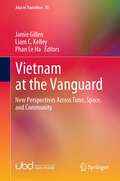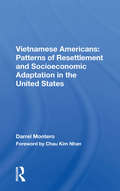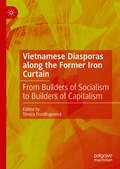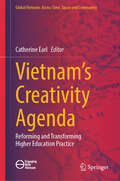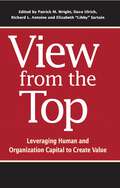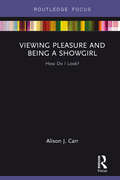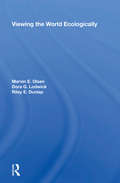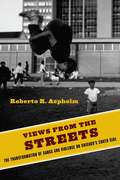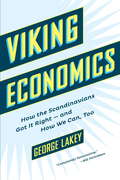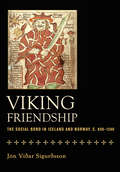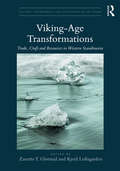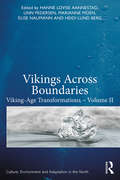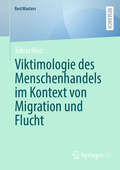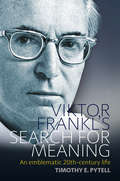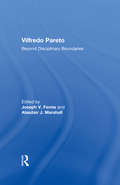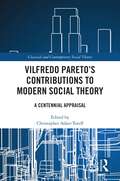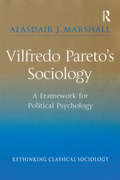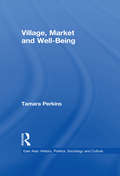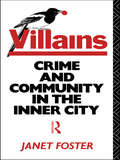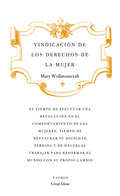- Table View
- List View
Vietnam at the Vanguard: New Perspectives Across Time, Space, and Community (Asia in Transition #15)
by Le Ha Phan Jamie Gillen Liam C. KelleyThis transdisciplinary edited book explores new developments and perspectives on global Vietnam, touching on aspects of history, identity, transnational mobilities, heritage, belonging, civil society, linguistics, education, ethnicity, and worship practices. Derived from the Engaging With Vietnam: An Interdisciplinary Dialogue conference series, this cutting-edge collection presents new scholarship and also represents new ways of knowing global Vietnam. Over the past 10 years, knowledge production about Vietnam has diversified in various ways as globalization, the internationalization of higher education, and the digital revolution have transformed the world, as well as Vietnam. Whereas as late as a decade ago, knowledge about Vietnam was still largely the preserve of scholars in Vietnam and a coterie of related experts outside of the country at a select few universities, today we find scholars working on Vietnam in myriad contexts. This transformation has introduced new voices and new perspectives, which this book champions. A critical text engaging a range of historical and contemporary debates about Vietnam, this book is an indispensable volume for the Southeast Asian Studies student and scholar in the humanities and social sciences.
Vietnamese Americans: Patterns Of Resettlement And Socioeconomic Adaptation In The United States
by Darrel MonteroAs of November 1978, more than 170,000 Indochinese refugees had come to the United States after a traumatic flight from their native land, arriving with little preparation for the changes they would face. This book documents and analyzes this unique migration and, employing data from a national sample, reports on the changing socioeconomic status of the Vietnamese refugees. Dr. Montero presents and analyzes data on the refugees' employment, education, income, receipt of federal assistance, and proficiency in the English language; his model of Spontaneous International Migration (SIM) places the Vietnamese immigration experience in a broader sociohistorical context. He has found that, despite the myriad of problems the newcomers have faced, they have been adapting successfully to life in the United States, and in only three years have made remarkable social and economic progress.
Vietnamese Diasporas along the Former Iron Curtain: From Builders of Socialism to Builders of Capitalism
by Tereza FreidingerováThis book examines how socialism and post-socialism influenced or determined (if at all) the adaptive behavior and entrepreneurial activities, both legal and illegal, of the Vietnamese in Central Europe (CE). It considers the circumstances that accompanied the establishment of the migration channel between Vietnam and CE, the geopolitical changes that enabled the formation of Vietnamese diasporas, and the development of Vietnamese business. The authors argue that the rapid emergence and relative success of Vietnamese business after the change in regime was made possible by different factors such as the already existing illicit trade established under socialism, the hunger of (post-)socialist society for consumer goods, the significant economic differences between neighbouring CE countries after the fall of the Iron Curtain, the relatively similar initial post-1989 conditions for both majority and Vietnamese entrepreneurs, and, especially, the socialist moral flexibility and the silent agreement that accepted illicit, quasi-legal, and non-standard practices inherent to the business environment of the entire socialist and post-socialist area. Finally, the authors suggest that the establishment of a network, encompassing both formal and informal business relationships within CE, led to the creation of a unique spatial layer that more or less ignores state borders, referred to as a &“Vietscape&” – a breeding ground for the development of Vietnamese business in CE that has been significantly transnational since its inception.
Vietnam’s Creativity Agenda: Reforming and Transforming Higher Education Practice (Global Vietnam: Across Time, Space and Community)
by Catherine EarlThis book gathers a diverse set of empirical research chapters from practitioners in the higher education sector in Vietnam to explore the effects of higher education reform on university learning and teaching from the point of view of the classroom educators. Through action research, reflective practice, and other qualitative methods, the book investigates the transformations of learning and teaching practice from top-down to bottom-up, teacher-centred to student-centred, curriculum-oriented to skills-based, institutionally directed to partner integrated, and co-designed approaches. In doing so, the book challenges a rethinking of Vietnamese higher education. It reveals the ingredients for transformative education and calls for educators to be empowered with support, resources, and trust. Drawing on a broad range of disciplinary backgrounds about Vietnam’s university reforms, it is highly relevant to social anthropologists, educational specialists, and policymakers working in higher education reform, not only in Vietnam and other Southeast Asian contexts, but globally.
View from the Top: Leveraging Human and Organization Capital to Create Value (Making an Impact in Small Business HR)
by Patrick WrightOrganizations face mounting pressure to thrive amid volatility, uncertainty, complexity and ambiguity. View from the Top explores how HR leaders can turn these challenges into competitive advantages by building robust human and organizational capital. Drawing on contributions from prominent chief human resource officers and HR thought leaders, the book offers real-world case studies, conceptual models and original research that together create a comprehensive roadmap for value creation. It provides insight into how strategic HR can address current challenges while positioning organizations for long-term success.Essential reading for HR professionals and business leaders, this book bridges theory and practice to equip readers with tools and frameworks they can apply directly in their own organizations.
Viewing Pleasure and Being a Showgirl: How Do I Look? (Sexualities in Society)
by Alison J. CarrDrawing on interviews with a breadth of different showgirls, from shows in Paris, Las Vegas, Berlin, and Los Angeles, as well as her own artworks and those by other contemporary and historical artists, this book examines the experiences of showgirls and those who watch them, to challenge the narrowness of representations and discussions around what has been termed ‘sexualisation’ and ‘the gaze’. An account of the experience of being ‘looked at’, the book raises questions of how the showgirl is represented, the nature of the pleasure that she elicits and the suspicion that surrounds it, and what this means for feminism and the act of looking. An embodied articulation of a new politics of looking, Viewing Pleasure and Being a Showgirl engages with the idea (reinforced by feminist critique) that images of women are linked to selling and that women’s bodies have been commodified in capitalist culture, raising the question of whether this enables particular bodies – those of glamorous women on display – to become scapegoats for our deeper anxieties about consumerism.
Viewing The World Ecologically
by Marvin E. OlsenDuring the last 20 years, the American public has become increasingly aware of environmental problems and resource scarcities. This study focuses on the rapid emergence of an ecological social paradigm, which appears to be replacing the technological social paradigm that has dominated American culture throughout most of the 20th century.
Views from the Streets: The Transformation of Gangs and Violence on Chicago's South Side (Studies in Transgression)
by Roberto AspholmChicago has long served as a symbol of urban pathology in the public imagination. The city’s staggering levels of violence and entrenched gang culture occupy a central place in the national discourse, yet remain poorly understood and are often stereotyped. Views from the Streets explains the dramatic transformation of black street gangs on Chicago’s South Side during the early twenty-first century, shedding new light on why gang violence persists and what might be done to address it.Drawing on years of community work and in-depth interviews with gang members, Roberto R. Aspholm describes in vivid detail the internal rebellions that shattered the city’s infamous corporate-style African American street gangs. He explores how, in the wake of these uprisings, young gang members have radically refashioned gang culture and organization on Chicago’s South Side, rejecting traditional hierarchies and ideologies and instead embracing a fierce ethos of personal autonomy that has made contemporary gang violence increasingly spontaneous and unregulated. In calling attention to the historical context of these issues and to the elements of resistance embedded in Chicago’s contemporary gang culture, Aspholm challenges conventional views of gang members as inherently pathological. He critically analyzes highly touted “universal” violence prevention strategies, depicting street-level realities to illuminate why they have ultimately failed to reduce levels of bloodshed. An unprecedented analysis of the nature and meaning of gang violence, Views from the Streets proposes an alternative framework for addressing the seemingly intractable issues of inequality, despair, and violence in Chicago.
Vigilante Gender Violence: Social Class, the Gender Bargain, and Mob Attacks on Women Worldwide
by Rebecca ÁlvarezIn recent years, mob attacks on women by men have drawn public attention to an emerging social phenomenon. This book draws upon concepts from critical race theory and sociocultural evolutionary theory to examine this specific form of gender violence, which takes place outside the law and is a vigilante form of enforcing traditional gender norms. The author positions vigilante gender violence as a global issue produced during specific periods of sociocultural change in conditions marked by intensified social stratification. The catalyst for vigilante gender violence is the formal state’s breaching of the "gender bargain," the tacit psychological wage even non-elite men earn by at least not being female. When the state threatens to end the gender bargain by promoting women’s rights, the die is cast for low-status men to enforce this bargain themselves in mob attacks against women who are perceived to be violating the patriarchal order. Seen through independent case studies in different national settings, this book provides empirical evidence that demonstrates the existence of vigilante gender violence in times when societies are shifting from one phase to another and the social hierarchies present within are disrupted. With greater understanding of when and how to predict the occurrence of this phenomenon, the author posits notable ways to prevent it from happening altogether.
Viking Economics: How the Scandinavians Got It Right-and How We Can, Too
by George LakeyLiberals worldwide invoke Scandinavia as a promised land of equality, while most conservatives fear it as a hotbed of liberty-threatening socialism. But the left and right can usually agree on one thing: that the Nordic system is impossible to replicate elsewhere. The US and UK are too big, or too individualistic, or too . . . something. In Viking Economics--perhaps the most fun economics book you've ever read--George Lakey dispels these myths. He explores the inner-workings of the Nordic economies that boast the world's happiest, most productive workers, and explains how, if we can enact some of the changes the Scandinavians fought for surprisingly recently, we, too, can embrace equality in our economic policy.
Viking Friendship: The Social Bond in Iceland and Norway, c. 900-1300
by Jon Vidar Sigurdsson"To a faithful friend, straight are the roads and short."—Odin, from the Hávamál (c. 1000) Friendship was the most important social bond in Iceland and Norway during the Viking Age and the early Middle Ages. Far more significantly than kinship ties, it defined relations between chieftains, and between chieftains and householders. In Viking Friendship, Jón Viðar Sigurðsson explores the various ways in which friendship tied Icelandic and Norwegian societies together, its role in power struggles and ending conflicts, and how it shaped religious beliefs and practices both before and after the introduction of Christianity.Drawing on a wide range of Icelandic sagas and other sources, Sigurðsson details how loyalties between friends were established and maintained. The key elements of Viking friendship, he shows, were protection and generosity, which was most often expressed through gift giving and feasting. In a society without institutions that could guarantee support and security, these were crucial means of structuring mutual assistance. As a political force, friendship was essential in the decentralized Free State period in Iceland’s history (from its settlement about 800 until it came under Norwegian control in the years 1262–1264) as local chieftains vied for power and peace. In Norway, where authority was more centralized, kings attempted to use friendship to secure the loyalty of their subjects. The strong reciprocal demands of Viking friendship also informed the relationship that individuals had both with the Old Norse gods and, after 1000, with Christianity’s God and saints. Addressing such other aspects as the possibility of friendship between women and the relationship between friendship and kinship, Sigurðsson concludes by tracing the decline of friendship as the fundamental social bond in Iceland as a consequence of Norwegian rule.
Viking-Age Transformations: Trade, Craft and Resources in Western Scandinavia (Culture, Environment and Adaptation in the North)
by Zanette T. Glørstad Kjetil LoftsgardenThe Viking Age was a period of profound change in Scandinavia. As kingdoms were established, Christianity became the encompassing ideological and cosmological framework and towns were formed. This book examines a central backdrop to these changes: the economic transformation of West Scandinavia. With a focus on the development of intensive and organized use of woodlands and alpine regions and domestic raw materials, together with the increasing standardization of products intended for long-distance trade, the volume sheds light on the emergence of a strong interconnectedness between remote rural areas and central markets. Viking-Age Transformations explores the connection between legal and economic practice, as the rural economy and monetary system developed in conjunction with nascent state power and the legal system. Thematically, the book is organized into sections addressing the nature and extent of trade in both marginal and centralized areas; production and the social, legal and economic aspects of exploiting natural resources and distributing products; and the various markets and sites of trade and consumption. A theoretically informed and empirically grounded collection that reveals the manner in which relationships of production and consumption transformed Scandinavian society with their influence on the legal and fiscal division of the landscape, this volume will appeal to scholars of archaeology, the history of trade and Viking studies.
Vikings Across Boundaries: Viking-Age Transformations – Volume II (Culture, Environment and Adaptation in the North)
by Hanne Lovise AannestadThis volume explores the changes that occurred during the Viking Age, as Scandinavian societies fell in line with the larger forces that dominated the Insular world and Continental Europe, absorbing the powerful symbiosis of Christianity and monarchy, adapting to the idea of royal lineage and supremacy, and developing a buzzing urbanism coupled with large-scale trade networks. Presenting research on the grand context of the Viking Age alongside localised studies, it contributes to the furthering of collaborations between local and ‘outsider’ research on the Viking Age. Through a diversity of approaches on the Viking homelands and the wider world of the Vikings, it offers studies of a range of phenomena, including urban and rural settlements; continuity in the use of places as well as new types of places specific to the Viking Age; the social significance of change; the construction and maintenance of social identity both within the ‘homelands’ and across large territories; ethnicity; and ideas of identity and the creation and recreation of identity both at home and abroad. As such, it will appeal to historians and archaeologists with interests in Viking-Age studies, as well as scholars of Scandinavian studies.
Viktimologie des Menschenhandels im Kontext von Migration und Flucht (BestMasters)
by Tobias HinzMenschenhandel findet auch außerhalb des Kontextes von Migration und Flucht statt. Dennoch bergen das Vorhandensein fluchtrelevanter Gründe oder migrationsspezifische Prozesse besondere Risiken, die tatbegehenden Personen durch Ausnutzung der Migrationsmotive potenzieller Opfer in die Karten spielen. Tobias Hinz wirft daher einen Blick auf die Viktimisierungsprozesse und versucht der Problematik unter Hinzuziehung verschiedener Perspektiven und Aspekte nachzugehen. Hierzu führt er in den ersten Kapiteln zunächst in die Thematik "Menschenhandel" ein und erklärt dessen Definition und Phänomenologie. Im weiteren Verlauf erfolgt eine Darstellung relevanter aufenthalts- und asylrechtlicher Grundlagen, ergänzt durch daraus resultierende migrations- und fluchtspezifische Einflussfaktoren. Nach einer Erläuterung etablierter viktimologischer Grundlagen und Theorien stellt der Autor seine eigene Theorie zur Erklärung des Opferverhaltens dar.
Viktor Frankl's Search for Meaning
by Timothy PytellFirst published in 1946, Viktor Frankl's memoir Man's Search for Meaning remains one of the most influential books of the last century, selling over ten million copies worldwide and having been embraced by successive generations of readers captivated by its author's philosophical journey in the wake of the Holocaust. This long-overdue reappraisal examines Frankl's life and intellectual evolution anew, from his early immersion in Freudian and Adlerian theory to his development of the "third Viennese school" amid the National Socialist domination of professional psychotherapy. It teases out the fascinating contradictions and ambiguities surrounding his years in Nazi Europe, including the experimental medical procedures he oversaw in occupied Austria and a stopover at the Auschwitz concentration camp far briefer than has commonly been assumed. Throughout, author Timothy Pytell gives a penetrating but fair-minded account of a man whose paradoxical embodiment of asceticism, celebrity, tradition, and self-reinvention drew together the complex strands of twentieth-century intellectual life.
Vilfredo Pareto: Beyond Disciplinary Boundaries
by Joseph V. Femia Alasdair J. MarshallThis collection examines the work of the Italian economist and social theorist Vilfredo Pareto, highlighting the extraordinary scope of his thought, which covers a vast range of academic disciplines. The volume underlines the enduring and contemporary relevance of Pareto's ideas on a bewildering variety of topics; while illuminating his attempt to unite different disciplines, such as history and sociology, in his quest for a 'holistic' understanding of society. Bringing together the world's leading experts on Pareto, this collection will be of interest to scholars working in the fields of sociology and social psychology, monetary theory and risk analysis, philosophy and intellectual history, and political science and rhetoric.
Vilfredo Pareto’s Contributions to Modern Social Theory: A Centennial Appraisal (Classical and Contemporary Social Theory)
by Christopher Adair-ToteffThis volume seeks to restore Vilfredo Pareto to his rightful place in the history of social and economic thought, bringing together studies by leading scholars to mark the centenary of his death in 1923. Assessing Pareto’s many contributions to the social sciences and his unique integration of the disciplines of sociology, politics, and economics, it addresses the relative neglect of Pareto’s work and explores both his continuing relevance to social research and the influence of his thought on subsequent developments in sociology and social theory. As such it will appeal to scholars across the social sciences with interests in the history of sociology and the importance of Pareto’s thought.
Vilfredo Pareto’s Sociology: A Framework for Political Psychology (Rethinking Classical Sociology Ser.)
by Alasdair J. MarshallVilfredo Pareto is a key figure in the history of economics and sociology. His sociological works attempted to merge these two disciplines through a psychologistic analysis of society, economy and politics. This is the first book to rethink Pareto's contribution to classical sociology by focusing upon its psychological underpinning. The author locates the origins of Pareto's psychologistic approach both within the history of Italian thought and within Pareto's own experiences of business and politics. He evaluates Pareto's sociology through the lens of contemporary social science, examining whether its explanatory power is growing rather than diminishing as levels of social and epistemological complexity rise. The volume also explores Pareto's assumptions about personality through the lens of contemporary psychology. It concludes with a psychometric study of Westminster MPs which clarifies and attests to Pareto's contemporary relevance, and indicates that even practitioners of politics may gain much from reading Pareto.
Villa Victoria: The Transformation of Social Capital in a Boston Barrio
by Mario Luis SmallFor decades now, scholars and politicians alike have argued that the concentration of poverty in city housing projects would produce distrust, alienation, apathy, and social isolation--the disappearance of what sociologists call social capital. But relatively few have examined precisely how such poverty affects social capital or have considered for what reasons living in a poor neighborhood results in such undesirable effects. This book examines a neglected Puerto Rican enclave in Boston to consider the pros and cons of social scientific thinking about the true nature of ghettos in America. Mario Luis Small dismantles the theory that poor urban neighborhoods are inevitably deprived of social capital. He shows that the conditions specified in this theory are vaguely defined and variable among poor communities. According to Small, structural conditions such as unemployment or a failed system of familial relations must be acknowledged as affecting the urban poor, but individual motivations and the importance of timing must be considered as well. Brimming with fresh theoretical insights, Villa Victoria is an elegant work of sociology that will be essential to students of urban poverty.
Village Ties: Women, NGOs, and Informal Institutions in Rural Bangladesh
by Nayma QayumAcross the global South, poor women’s lives are embedded in their social relationships and governed not just by formal institutions – rules that exist on paper – but by informal norms and practices. Village Ties takes the reader to Bangladesh, a country that has risen from the ashes of war, natural disaster, and decades of resource drain to become a development miracle. The book argues that grassroots women’s mobilization programs can empower women to challenge informal institutions when such programs are anti-oppression, deliberative, and embedded in their communities. Qayum dives into the work of Polli Shomaj (PS), a program of the development organization BRAC to show how the women of PS negotiate with state and society to alter the rules of the game, changing how poor people access resources including safety nets, the law, and governing spaces. These women create a complex and rapidly transforming world where multiple overlapping institutions exist – formal and informal, old and new, desirable and undesirable. In actively challenging power structures around them, these women defy stereotypes of poor Muslim women as backward, subservient, oppressed, and in need of saving.
Village, Market and Well-Being (East Asia: History, Politics, Sociology and Culture)
by Tamara PerkinsFirst published in 2002. Routledge is an imprint of Taylor & Francis, an informa company.
Villains - Foster
by Janet Foster"Villians" provides a rare insight into local and family traditions of petty crime. It looks at attitudes to crime and law enforcement, and the relationship of those attitudes to the culture in which they are expressed. This book should be of interest to students and teachers in police studies, ethnomethodology and women's studies.
Vindicación de los derechos de la mujer (Serie Great Ideas #Volumen 19)
by MARY WOLLSTONECRAFTIdeas que han cambiado el mundo. A lo largo de la historia, algunos libros han cambiado el mundo. Han transformado la manera en que nos vemos a nosotros mismos y a los demás. Han inspirado el debate, la discordia, la guerra y la revolución. Han iluminado, indignado, provocado y consolado. Han enriquecido vidas, y también las han destruido. Taurus publica las obras de los grandes pensadores, pioneros, radicales y visionarios cuyas ideas sacudieron la civilización y nos impulsaron a ser quienes somos. Esta apasionada declaración de independencia de la mujer escrita por Mary Wollstonecraft hizo añicos el estereotipo de la dama dócil y ornamental, anticipando una nueva era de igualdad y consagrando a su autora como fundadora del feminismo moderno. Comentarios sobre la colección Great Ideas:«De veras que la edición es primorosa y pocas veces contenido y continente pueden encontrarse mejor ensambladosy unidos. ¡Qué portadas! Para enmarcar. [...] Ante las Great Ideas, solo cabe quitarse el sombrero. ¡Chapeau!»ABC «Taurus propone un doble envite con este lanzamiento. Por un lado aumenta su compromiso con el ensayo; por otro, recupera el gusto por la estética. A los volúmenes se les ha proporcionado una portada delicada y cuidada (copian el original británico) que invita a la lectura.»La Razón «Un fenómeno editorial.»The Guardian «Aparte de los contenidos, en general muy bien elegidos, son tan bonitos que si los ven seguro que cae alguno.»El País «Ideas revolucionarias, crónicas de exploraciones, pensamientos radicales vuelven a la vida en estas cuidadísimas ediciones, muy atractivas para nuevos lectores.»Mujer Hoy «Grandes ideas bien envueltas. De Cicerón a Darwin, esta colección entra por los ojos.»Rolling Stone «Original y bella iniciativa la emprendida por Taurus con su colección Great Ideas.»Cambio 16 «Hay libros inmortales, libros únicos que contienen pensamientos y reflexiones capaces de cambiar el mundo, tesoros en miniatura reagrupados en la colección Great ideas.»Diario de León
Vindicación de los derechos de la mujer (Tribuna Feminista Ser. #Vol. 18)
by MARY WOLLSTONECRAFT«No deseo que las mujeres tengan podersobre los hombres, sino sobre sí mismas.» Una nueva edición que incluye el prólogo de Nuria Varela. El término feminismo no existía cuando Mary Wollstonecraft escribió este libro, que fue, sin embargo, la primera gran obra de la literatura feminista. En una época en la que la defensa de los derechos humanos había llevado la revolución a América y a Francia, Mary Wollstonecraft produjo su propia declaración de independencia en 1792. Vindicación de los derechos de la mujer atacó la idea dominante de una feminidad dócil y decorativa, y sentó los principios de la emancipación femenina. En estas páginas encontrarás la esencia de sus ideas, a favor de la educación de las mujeres y de su contribución a la sociedad. Racionalista y revolucionaria a la vez, y sin más poder que su pluma, Mary Wollstonecraft puso en marcha el movimiento que cambiaría el mundo para siempre y que, más de dos siglos después, continúa transformándolo. Prólogo de NURIA VARELA Traducción de MARTA LOIS GONZÁLEZ Comentarios sobre la colección Great Ideas:«De veras que la edición es primorosa y pocas veces contenido y continente pueden encontrarse mejor ensamblados y unidos. ¡Qué portadas! Para enmarcar. [...] Ante las Great Ideas, solo cabe quitarse el sombrero. ¡Chapeau!»ABC «Taurus propone un doble envite con este lanzamiento. Por un lado aumenta su compromiso con el ensayo; por otro, recupera el gusto por la estética. A los volúmenes se les ha proporcionado una portada delicada y cuidada (copian el original británico) que invita a la lectura.»La Razón «Un fenómeno editorial.»The Guardian «Aparte de los contenidos, en general muy bien elegidos, son tan bonitos quesi los ven seguro que cae alguno.»El País «Ideas revolucionarias, crónicas de exploraciones, pensamientos radicales vuelven a la vida en estas cuidadísimas ediciones, muy atractivas para nuevos lectores.»Mujer Hoy «Grandes ideas bien envueltas. De Cicerón a Darwin, esta colección entra por los ojos.»Rolling Stone «Original y bella iniciativa la emprendida por Taurus con su colección Great Ideas.»Cambio 16 «Hay libros inmortales, libros únicos que contienen pensamientos y reflexiones capaces de cambiar el mundo, tesoros en miniatura reagrupados en la colección Great ideas.»Diario de León
Vinyl: The Analogue Record in the Digital Age
by Ian Woodward Dominik BartmanskiRecent years have seen not just a revival, but a rebirth of the analogue record. More than merely a nostalgic craze, vinyl has become a cultural icon. As music consumption migrated to digital and online, this seemingly obsolete medium became the fastest-growing format in music sales. Whilst vinyl never ceased to be the favorite amongst many music lovers and DJs, from the late 1980s the recording industry regarded it as an outdated relic, consigned to dusty domestic corners and obscure record shops. So why is vinyl now experiencing a ‘rebirth of its cool’?Dominik Bartmanski and Ian Woodward explore this question by combining a cultural sociological approach with insights from material culture studies. Presenting vinyl as a multifaceted cultural object, they investigate the reasons behind its persistence within our technologically accelerated culture. Informed by media analysis, urban ethnography and the authors’ interviews with musicians, DJs, sound engineers, record store owners, collectors and cutting-edge label chiefs from a range of metropolitan centres renowned for thriving music scenes including London, New York, Tokyo, Melbourne, and especially Berlin, what emerges is a story of a modern icon.
